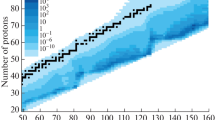Abstract
A stochastic theory for a branching process in a neutron population with two energy levels is used to assess the applicability of the differential self-interrogation Feynman-alpha method by numerically estimated reaction intensities from Monte Carlo simulations. More specifically, the variance to mean or Feynman-alpha formula is applied to investigate the appearing exponentials using the numerically obtained reaction intensities.
Similar content being viewed by others
References
W. Kunz, J.T. Caldwell, J.D. Atencuo, Apparatus and method for quantitative assay of generic transuranic wastes from nuclear reactors, US Patent 4,483,816, March (1982).
S. Croft, B. Mc Elroy, L. Bourva, M. Villani, Evaluation of the Minimum Detectable Quantities of Fissile Material in a Differential Die-Away Chamber, Waste Management Conf. Proc. (2003).
K.A. Jordan, Detection of Special Nuclear Material in Hydrogenous Cargo Using Differential Die-Away Analysis, PhD Thesis, Department of Nuclear Engineering, University of California, Berkeley (2006).
K.A. Jordan, T. Gozani, Nucl. Instrum. Methods B 261, 365 (2007).
K.A. Jordan, T. Gozani, J. Vujic, Nucl. Instrum. Methods A 598, 436 (2008).
H.O. Menlove, S.H. Menlove, S.T. Tobin, Nucl. Instrum. Methods A 602, 588 (2009).
L. Pál, I. Pázsit, Eur. Phys. J. Plus 126, 20 (2011).
I. Pázsit, L. Pál, A stochastic model of the differential die-away analysis (DDAA) method, in Proceedings 51st INMM 11 - 15 July, Baltimore, USA (2010).
R. Soule et al., Nucl. Sci. Eng. 148, 124 (2004).
J.-L. Muñoz-Cobo et al., Ann. Nucl. Energy 38, 590 (2011).
C. Berglöf et al., Ann. Nucl. Energy 38, 194 (2011).
J. Anderson, I. Pázsit, L. Pál, On the Feynman-alpha formula for fast neutrons, in Proceedings 33rd ESARDA 16-20 May, Budapest, Hungary (2011).
I. Pázsit, L. Pál, Neutron Fluctuations - A Treatise on the Physics of Branching Processes (Elsevier Ltd., 2008).
I. Pázsit, Y. Yamane, Ann. Nucl. Energy 25, 667 (1998).
J.F. Breismeister (Editor), MCNP, General Monte Carlo N-Particle Transport Code, Version 4, Los Alamos National Laboratory Report, LA - 12625 (1995).
Author information
Authors and Affiliations
Corresponding author
Rights and permissions
About this article
Cite this article
Anderson, J., Pál, L., Pázsit, I. et al. Derivation and quantitative analysis of the differential self-interrogation Feynman-alpha method. Eur. Phys. J. Plus 127, 21 (2012). https://doi.org/10.1140/epjp/i2012-12021-3
Received:
Revised:
Accepted:
Published:
DOI: https://doi.org/10.1140/epjp/i2012-12021-3




